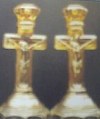Carnival Glass 101 | home Quick Reference to Carnival Glass Patterns on This Site
Decorated Carnival Glass - Part 2
DECORATED Carnival Glass - Part 2
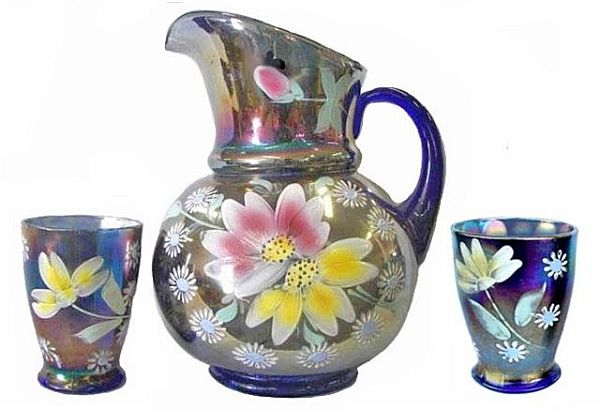
Northwood DAISY & LITTLE FLOWERS Water Set
DAISY & LITTLE FLOWERS: This pattern is referenced as Item #21 in The World of Enameled Carnival Glass Tumblers by Cecil Whitley. It stands 4 ¼ high and is 3 1/8 across the mouth. Blue is the base glass color, but as you can see, the painted design varies according to the strokes applied by the hand-painter. Each artist has individual touch. This can readily be observed as you tour the decorating department in the Fenton Art Glass Factory today!
Longtime collector, Greg Lockhart tells us that he has tumblers in this pattern which have 6, 7, and 8 flowers on, depending upon the whim of the artist's application!
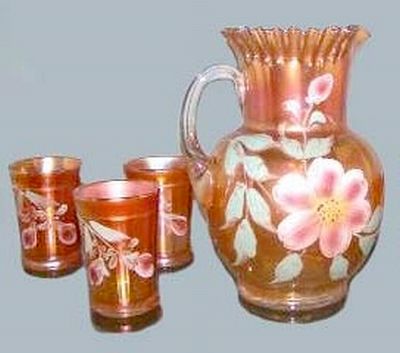
PRETTY PANELS
PRETTY PANELS: Not many Northwood tumblers have painted designs, but this one seems proportioned for that purpose, having a smooth surface. The panels referred to in the pattern name are all found inside the tumbler. 4 ¼ tall, with base and rim diameters of 2 ½ and 2 7/8 respectively. The convex interior panels are eighteen in number. Decorated pitchers each have their own distinction, with little carry-over of the painted design used on tumblers.
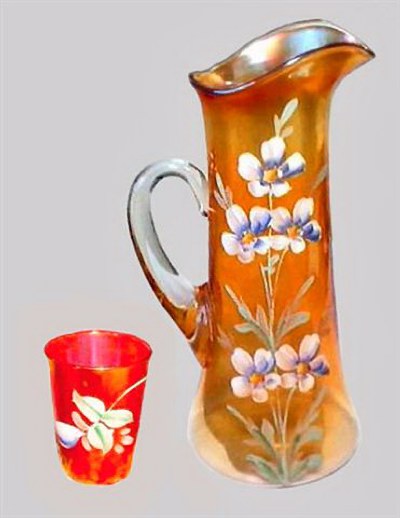
PERIWINKLE Tankard -12.75 in. tall.
PERIWINKLE: This painted design is found on three differently shaped vessels, creating question as to the maker in at least one case. The tall cylindrical tankard, virtually identical to Dugan's Lattice & Daisy tankard leads us to conclude that Dugan provided this example. Since Fenton and Northwood each created a bulbous, cannonball-type shape, we believe that either of those manufacturers could have produced this one. The third shape is conclusively Northwood in origin. It is mould-blown, cylindrical in shape, having a well-defined shoulder where body joins the neck. It is identical in shape to Northwood's Cosmos and Swirl Rib Variant #5 pitchers. Tumblers have factory ground base, with marigold being the only reported color.
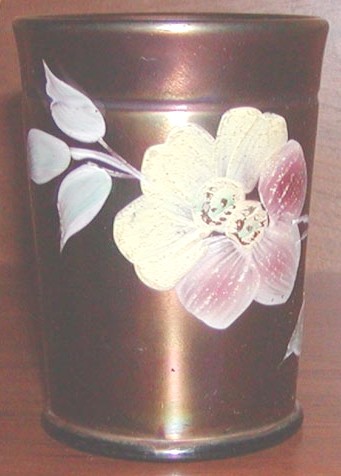
APPLE BLOSSOM in blue -
N in circle on the inside bottom.
APPLE BLOSSOM: One of two Northwood decorated designs which are pressed; not mould-blown. The design was also applied to berry sets and table sets. Smooth, raised panels on the interior and a plain exterior, very nicely accommodates the enameled decoration. The moulds are a revival of the 1904-1906 pre-iridescent line which Wm. Heacock named Barbella.
Cobalt blue is the only color found in these rare enameled pieces. The first examples of enameled table sets did not appear until 1995.
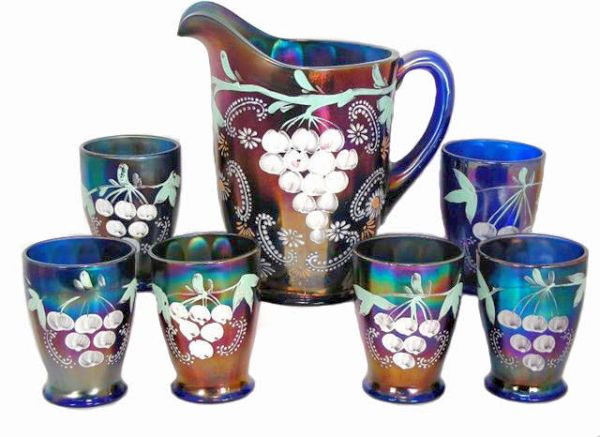
GROUND CHERRIES in Blue
Courtesy Mickey Reichel
GROUND CHERRIES: This is a pressed water set. Both pitcher and tumbler offer the same basic tapered, rounded shape. The tumbler mould is the same one used for the Daisy & Little Flowers. This rare set is known only in cobalt blue.
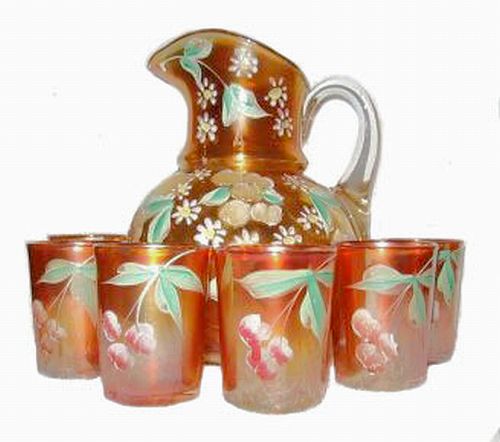
Cherries and Little Flowers
CHERRIES & LITTLE FLOWERS: Another mould-blown, bulbous pitcher, this one creates confusion, since Fenton produced a nearly identical set. Tumblers have a factory ground base and are occasionally found with the Northwood trademark. Some rare amethyst examples are known, with marigold considered scarce. Cobalt blue is more readily found.
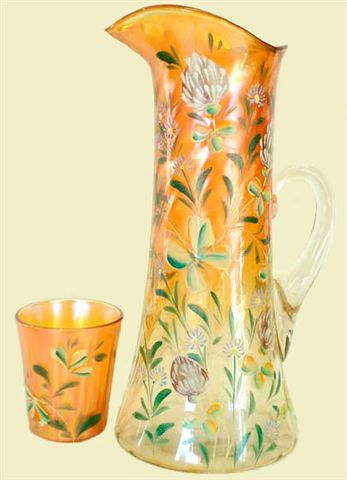
WINDFLOWER & CLOVER
WINDFLOWER & CLOVER: This rare set derives from Fenton manufacture and is seldom offered for sale. Marigold is the only reported color.
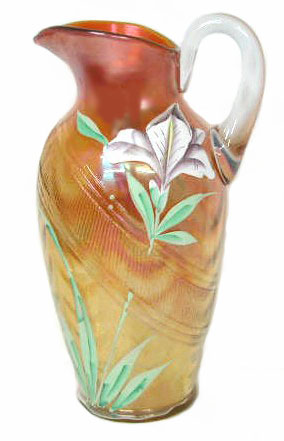
Enameled IRIS
IRIS: This tankard having the diagonal prism band is quite elegant in stature. Fenton gave us an exceedingly beautiful set with this design. Amethyst, marigold, blue, and some scarce green sets are known.
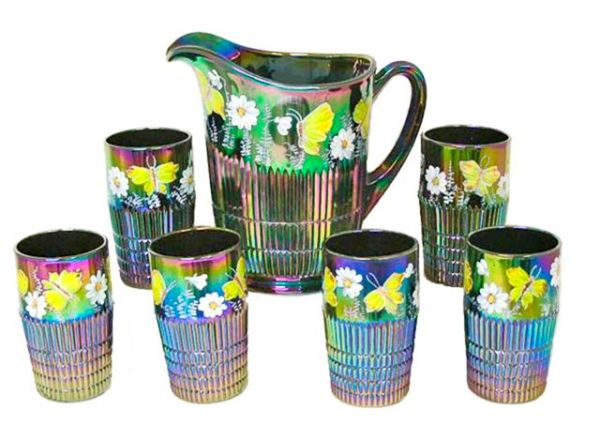
Hand Painted and Signed Louise Piper-8-5-81.
Fenton Black Amethyst
1981 Enameled set: We choose to offer this lovely set painted by the well-known and eminent Fenton artist, Louise Piper. During her years as leading painter among many other well-qualified painters in that department, she made quite an impression on the buying public, developing decorative and scenic displays on glass such as this black amethyst water set.
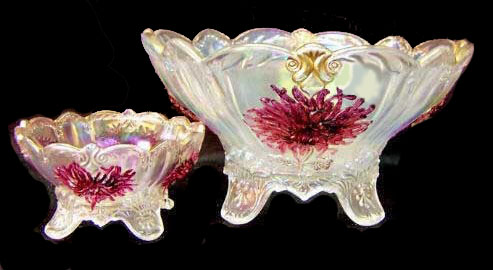 |
|
 |
|
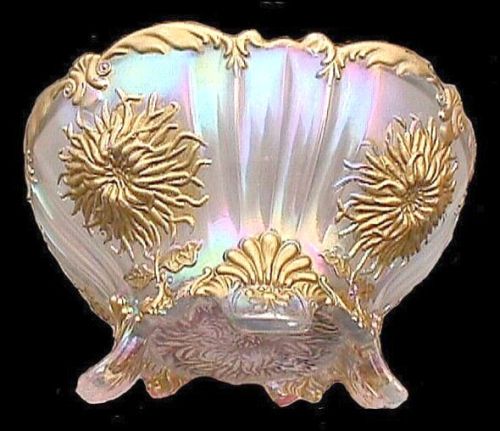 |
|
DAHLIA in White, accented with Gold deco.
9 in. Bowl - 4.5 in. deep.
|
DAHLIA: Dugan carnival production of this pattern dates to the 1912 period. It required some re-tooling of the Fan pattern. Berry sets, table sets and water sets are not easily found. Marigold pieces are more elusive than amethyst and white seems to be more prevalent. As for the stained examples: blue stained water sets are seen occasionally, but very few are found in white trimmed with gold or red stain. Much the same circumstance exists for the berry and table set components.
Ice blue, white and purple carnival water sets were produced by L.G. Wright Co., beginning in 1977. Non-iridized blue opalescent water sets were also produced. More recently, Mosser Glass Co. made water sets in red, pink opalescent, sapphire blue, and black amethyst. Some are iridized and some not. The new tumblers display only three Dahlia flowers, rather than four, as shown on the vintage tumblers. The rayed star used on the old examples is lacking on the new tumblers. White and purple are the only reproduced colors which were also found in the vintage pieces.
Dean & Diane Fry - 07/08
 |
|
So also is the resurrection of the dead. The body is sown in corruption, it is raised in incorruption.
It is sown in dishonor, it is raised in glory. It is sown in weakness, it is raised in power.
It is sown a natural body, it is raised a spiritual body. There is a natural body, and there is a spiritual body.
And so it is written, The first man Adam became a living being.
The last Adam became a life-giving spirit. However, the spiritual is not first, but the natural, and afterward the spiritual.
The first man was of the earth, made of dust; the second Man is the Lord from heaven.
As was the man of dust, so also are those who are made of dust;
and as is the heavenly Man, so also are those who are heavenly.
And as we have borne the image of the man of dust, we shall also bear the image of the heavenly Man.
(1 Corinthians 15: 42-49)
|
|
 |
Should you care to contact the Frys, their email address is:
Search Carnival Glass 101
back to Carnival Glass 101
Our other sites you may enjoy:
Everything you EVER wanted to know about Indiana Glass
Great Reference for Newer Carnival Glass.
Complete Glassware Catalogs Available to Download
Questions? Comments? Suggestions? Broken Links? Corrections?
Your Friendly Webmaster is here to help!
